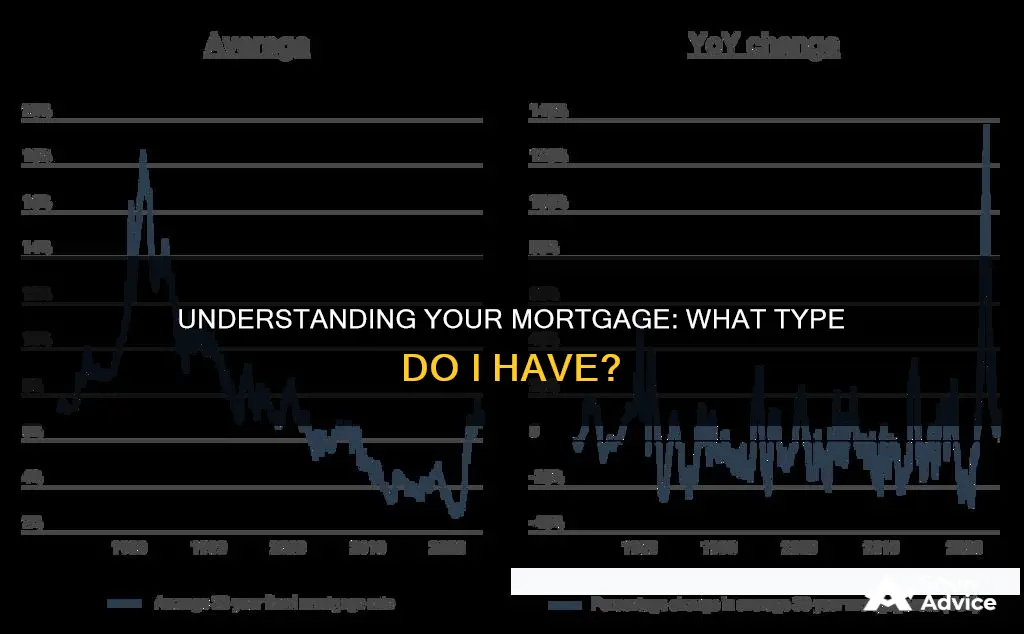
There are several types of mortgages available, and it is important to know which one you have to understand your options for getting help with your mortgage. The main types of mortgages are conventional loans, government-backed loans, jumbo loans, fixed-rate loans, and adjustable-rate loans. Conventional loans are any mortgages not backed by the federal government and typically have higher minimum credit score requirements than other loan types. Jumbo loans are a type of conventional loan that does not conform to the guidelines set by Fannie Mae and Freddie Mac. Government-backed loans include Federal Housing Administration (FHA) loans, which are ideal for borrowers with lower credit scores and smaller down payments. Fixed-rate mortgages maintain the same interest rate over the life of the loan, while adjustable-rate mortgages have variable interest rates. Other types of mortgages include construction loans, interest-only mortgages, and piggyback loans. To determine what type of mortgage you have, you can refer to your Closing Disclosure or Truth in Lending Disclosure statement.
How do I know what kind of mortgage I have?
| Characteristics | Values |
|---|---|
| Fixed-rate mortgage | The interest rate stays the same for the entire loan term |
| Adjustable-rate mortgage | The interest rate may change |
| Conventional mortgage | Any mortgage that isn't backed by the federal government |
| Government-backed mortgage | Backed by the U.S. Department of Veterans Affairs (VA) |
| Jumbo mortgage | Does not conform to the guidelines set by Fannie Mae and Freddie Mac |
| Construction-to-permanent loan | Used to build a home, converts to a traditional mortgage once the borrower moves in |
| Interest-only mortgage | Borrower makes interest-only payments for a set period, followed by payments for principal and interest |
| Piggyback loan | Two loans: one for 80% of the home price, another for 10% |
| FHA loan | Alternative to conventional financing, often a lower-rate option |
| Closing Disclosure | The type of interest rate is listed at the top of page 1 |
| Truth in Lending Disclosure statement | Language will indicate if you have a variable-rate feature |
| Promissory Note | Will indicate if the rate is adjustable |
What You'll Learn

Fixed-rate vs. adjustable-rate
When deciding on a mortgage, you'll need to consider whether to go for a fixed-rate or adjustable-rate option. Both have their pros and cons, and it's important to understand the differences between them.
With a fixed-rate mortgage, the interest rate is set at the beginning of the loan and will remain the same for the duration of the loan term. This means your monthly payments will not change, giving you predictability and certainty. Fixed-rate mortgages are generally considered the safer option and are the most popular type of financing. However, they typically have higher interest rates than adjustable-rate loans, particularly during the initial years. As a result, you could end up paying more interest if you plan to live in the house for a short period. Additionally, qualifying for a fixed-rate mortgage may be more challenging due to the higher monthly payments in the initial years.
On the other hand, an adjustable-rate mortgage (ARM) offers a low initial interest rate, usually lower than fixed-rate mortgages, for a fixed period, typically one, three, five, seven, or ten years. After this introductory period, the interest rate shifts to a "floating" rate, which can change with market conditions and may adjust upwards. This means your monthly payments can increase or decrease over the loan term, depending on the index rate. ARMs provide flexibility and can be attractive if you're looking to save money during the initial years of your loan. They also tend to have a more lenient approval process, making it easier to qualify.
It's important to carefully consider your financial situation and goals when deciding between a fixed-rate and adjustable-rate mortgage. Understand the potential risks and benefits of each option before making an informed decision.
Finding Your Mortgage: Record Number Search Simplified
You may want to see also

Conventional vs. government-backed
When it comes to mortgages, there are two primary categories: conventional mortgages and government-backed mortgages. Each has its own unique features, advantages, and drawbacks, catering to different financial situations and homebuying goals. Here is a detailed comparison between conventional and government-backed mortgages to help you understand their key differences.
Conventional Mortgages
Conventional mortgages are home loans offered by private lenders, including banks, credit unions, or online lenders. They are not insured by the federal government, which means they pose a higher risk for lenders. As a result, conventional loans typically have stricter qualification criteria. These loans are well-suited for borrowers with higher credit scores, larger down payments, and lower debt-to-income ratios. Conventional mortgages usually require a down payment of 20% to avoid Private Mortgage Insurance (PMI). If the down payment is less than 20%, PMI is required, but it can be dropped once the loan-to-value ratio reaches 80%. Conventional loans offer flexibility in terms of duration, with options such as 15 or 30-year terms. They also provide the freedom to purchase a wider variety of property types, including vacation homes and investment properties. For borrowers with excellent credit scores, conventional mortgages can be more cost-effective, often offering lower interest rates and lower PMI rates compared to government-backed loans.
Government-Backed Mortgages
Government-backed mortgages, on the other hand, are insured by the federal government. This means that if a borrower defaults on a government-backed loan, the government will pay the lender a portion of the loan amount. These mortgages are designed to provide a safety net for individuals who might struggle to qualify for traditional loans. They are ideal for first-time homebuyers, veterans, and residents of rural areas. Government-backed loans, such as FHA, VA, and USDA loans, typically offer lower interest rates and require less money upfront, making homeownership more accessible. Additionally, they have lower down payment requirements compared to conventional loans, and they are not as stringent about credit scores. However, one of the downsides of government-backed mortgages is the requirement for mortgage insurance, which can increase the monthly costs for homeowners. Furthermore, there are stricter rules regarding the type of property that can be purchased with these loans, which may be limiting for some buyers.
In conclusion, the choice between a conventional and a government-backed mortgage depends on your financial situation. It is crucial to assess your circumstances and goals before making this pivotal decision in your homebuying journey.
Avoid Mortgage Transfer: What You Need to Know
You may want to see also

Conforming vs. non-conforming
Conforming and non-conforming are two primary categories that mortgage loans typically fall under. Conforming loans are a type of conventional loan that adheres to the guidelines and standards established by government-sponsored enterprises such as Fannie Mae and Freddie Mac. These loans meet specific criteria related to size, credit score, and down payment. The Federal Housing Finance Agency (FHFA) sets loan limits each year, which Fannie and Freddie then need to follow. Conforming loans are more common than non-conforming loans and generally offer lower interest rates, resulting in lower lifetime borrowing costs.
Non-conforming loans, on the other hand, are mortgage loans that do not meet the requirements for a conforming loan. These loans often exceed the maximum loan limit for a particular area, and government-backed loans such as FHA, VA, and USDA loans are also considered non-conforming. Non-conforming loans may be the only option for borrowers looking to purchase a home with a listing price significantly above other properties in their area. Jumbo loans are a common type of non-conforming loan, known for their high loan amounts.
The process of securing a non-conforming loan may be quicker and require less documentation than a conforming loan. However, non-conforming loans often come with higher interest rates and stricter qualification requirements, such as higher credit scores, larger down payments, and lower debt-to-income ratios. The increased risk associated with non-conforming loans is the reason for these stricter requirements.
When deciding between a conforming and a non-conforming loan, it is essential to consider your financial situation, needs, and what you ultimately qualify for. Conforming loans may be a better choice if you are eligible and seeking more favourable terms, while non-conforming loans can provide more customized buying solutions and larger loan limits.
Understanding Your Mortgage: Are You Tenants-in-Common?
You may want to see also

Jumbo loans
A jumbo loan, also known as a jumbo mortgage, is a type of financing that exceeds the lending limits set by the Federal Housing Finance Agency (FHFA) for conventional mortgages. The FHFA determines the maximum amount for a conforming loan, which in 2025 is $806,500 in most counties. Homes that exceed this limit require a jumbo loan. For example, in 2025, a jumbo loan in most parts of the US is a mortgage of more than $806,500, although this amount varies by location. In some places, the conforming loan limit for single-family homes is as high as $1,149,825. Jumbo loans are considered nonconforming mortgages and carry more risk for the lender since they cannot be guaranteed or securitized by Fannie Mae or Freddie Mac.
To get approved for a jumbo loan, borrowers need to prove their financial health and ability to make payments. This includes demonstrating sufficient income, liquid assets, and cash reserves equivalent to six to twelve months' worth of mortgage payments. Self-employed individuals may face additional documentation requirements. Furthermore, some lenders may require multiple home appraisals to ensure that the property's value justifies the loan amount.
Understanding Your Mortgage: Is It a HELOC?
You may want to see also

FHA loans
An FHA loan is a Federal Housing Administration loan. FHA loans are a good option for those with a low credit score or existing debt. They are also available to first-time buyers who can only afford a low down payment. For example, a buyer with a credit score of 580 or above can borrow up to 96.5% of a home's value, with a down payment of just 3.5%. Buyers with a credit score between 500 and 579 may still qualify for an FHA loan, but they will need to make a 10% down payment.
Understanding Your Mortgage: Finding the Principal Balance
You may want to see also
Frequently asked questions
There are several types of mortgages, including conventional, jumbo, government, fixed-rate, and adjustable-rate. You can determine the type of mortgage you have by reviewing the relevant documentation, such as your Closing Disclosure or Truth in Lending Disclosure statement. These documents will indicate the type of interest rate associated with your mortgage, which is a key factor in determining the specific type of mortgage you have.
A fixed-rate mortgage maintains the same interest rate over the life of the loan, resulting in consistent monthly payments. On the other hand, an adjustable-rate mortgage (ARM) has a variable interest rate that can change over time, causing fluctuations in your monthly payments.
It is important to know who owns your loan to understand the available options for assistance. You can use online lookup tools, such as the Loan Look-Up Tool provided by Freddie Mac, to quickly determine if your loan is owned by a specific entity. Accurate and complete information is essential when using these tools to avoid inaccurate results.







